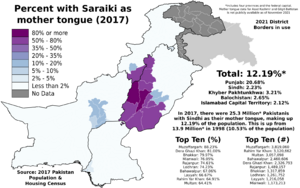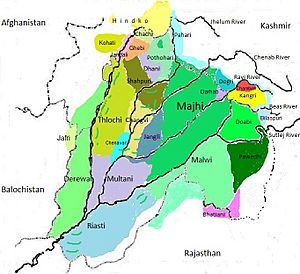Saraiki language facts for kids
Quick facts for kids Saraiki |
||||
|---|---|---|---|---|
| سرائیکی | ||||

Saraiki in Shahmukhi script (Nastaʿlīq style)
|
||||
| Native to | Pakistan | |||
| Region | Southern Punjab. Minority in Derajat and Northern Sindh | |||
| Ethnicity | Punjabi, Baloch | |||
| Native speakers | 28.84 Million (date missing) | |||
| Language family |
Indo-European
|
|||
| Writing system | Perso-Arabic (Saraiki alphabet) Devanagari Gurmukhi Multani |
|||
| Official status | ||||
| Regulated by | Saraiki area study centre (SASC), BZU Multan | |||

The proportion of people with Saraiki as their mother tongue in each Pakistani District as of the 2017 Pakistan Census
|
||||
|
||||
Saraiki ( سرائیکی Sarā'īkī; also spelled Siraiki or Seraiki) is a language spoken by about 28.84 million people. It belongs to the Indo-Aryan language family. Most Saraiki speakers live in Southern Punjab, Pakistan. You can also find speakers in Northern Sindh and the Derajat area. This language was once known as Multani.
Saraiki is quite similar to Standard Punjabi. They share many words and grammar rules. However, Saraiki sounds different, especially because it doesn't use tones like Punjabi. It also has special sounds called "implosive consonants." Saraiki also shares some important grammar features with the Sindhi language. Some people in Pakistan want Saraiki to be recognized as an official language for its own region.
The idea of Saraiki as a separate language identity became strong in the 1960s. Before that, people used more local names like Multani or Derawi. Some Pakistani politicians believe that the movement to make Saraiki a separate language was supported by important landowners in the Saraiki area.
Like many other languages in Pakistan, Saraiki is always adding new words. This happens because of popular languages in Pakistani media, such as Urdu, Standard Punjabi, and English. Also, Arabic and Persian have influenced Saraiki due to their religious importance.
What's in a Name?
The name Sirāikī became widely used recently, especially during a movement in the 1960s. However, it has been used for a long time in Sindh. There, it described the language of people who moved from the north. These were mainly Saraiki-speaking Baloch tribes who settled between the 1500s and 1800s.
In Sindh, the name likely meant "the language of the north." This comes from the Sindhi word siro, which means 'up-river' or 'north'. Sometimes, this name could also mean northern dialects of Sindhi. But today, those are usually called "Siroli" or "Sireli."
Another idea is that Sarākī comes from the word sauvīrā. This was an ancient kingdom mentioned in the old Sanskrit story, the Mahabharata.
Today, the most common way to spell the name is Saraiki. But you might also see Seraiki and Siraiki in older books. No matter the spelling, leaders in the 1960s chose this name to represent the language.
How Saraiki is Related to Other Languages
Saraiki is part of the Western Punjabi group. This group belongs to the Indo-Aryan family, which is a branch of the larger Indo-Iranian family. All of these are part of the huge Indo-European language family.
In 1919, a language expert named Grierson said that the languages in southwest Punjab, Pakistan, were a group he called "Southern Lahnda." Later experts agreed that these languages were related. However, they didn't use the name "Southern Lahnda" or even "Lahnda" itself. Grierson had used "Lahnda" to describe different languages spoken north, west, and south of Lahore. The main language in Lahore is Majhi dialect, which is the basis for standard Punjabi.
Saraiki is seen as a language that connects Punjabi and Sindhi. It is spoken in Upper Sindh and southern Punjab. Sometimes, people think of it as a dialect of either Sindhi or Punjabi. This is because speakers of these languages can often understand each other.
Different Ways of Speaking Saraiki
Here are some of the different ways Saraiki is spoken:
- Central Saraiki: This includes the Multani way of speaking. You can hear it in areas like Dera Ghazi Khan, Muzaffargarh, Leiah, Multan, and Bahawalpur.
- Southern Saraiki: This is common in Rajanpur and Rahimyar Khan areas.
- Sindhi Siraiki: This is spoken across the Sindh province and in the Kachhi Plain in Balochistan.
- Northern Saraiki (Thali): This is spoken in Dera Ismail Khan and the northern parts of the Thal region. This includes Mianwali District and Bhakkar District.
Historically, the names for Saraiki dialects could be confusing. For example, "Jaṭki" means "of the Jaṭṭs." But only a few Saraiki speakers are Jaṭṭs, and not all Jaṭṭs speak the same Saraiki dialect. However, these people often call their traditions and language Jataki. Also, some Saraiki dialects have many names depending on the place or group of people. For example, "Derawali" is used for local dialects in both Dera Ghazi Khan and Dera Ismail Khan. But the "Ḍerawali" in Dera Ghazi Khan is the Multani dialect, and in Dera Ismail Khan, it's the Thaḷi dialect.
When you read older information (before 2000), remember that Pakistan's administrative borders have changed often. Provinces are divided into districts. So, descriptions of Saraiki dialects often refer to these districts. Since Pakistan became a country in 1947, many districts have been divided, some more than once.
Is it a Language or a Dialect?
In South Asia, it can be tricky to decide if something is a "language" or a "dialect." Both Saraiki and Standard Panjabi can be seen as "dialects" of a "Greater Punjabi" super-language.
Most British officials used to think Saraiki was a dialect of Punjabi. Many Punjabis still see it that way. However, Saraiki speakers believe it is a language on its own. They feel that calling it a "dialect" is unfair.
A language movement began in the 1960s to create a standard writing system and promote Saraiki. The national census of Pakistan has been counting Saraiki speakers since 1981.
Where Saraiki is Spoken
In Pakistan
Saraiki is mainly spoken in the southwest part of Punjab province. This area is roughly where a new province called South Punjab Province might be created. To the west, the Suleiman Range separates Saraiki speakers from those who speak Pashto and Balochi. To the southeast, the Thar desert separates it from the Marwari language.
The other borders are not as clear. Punjabi is spoken to the east. Sindhi is found to the south, after the border with Sindh province. To the north, the southern edge of the Salt Range roughly divides Saraiki from northern Lahnda languages like Pothwari.
About 29 million people in Pakistan speak Saraiki as their first language, according to the 2023 census. The first time Pakistan's national census collected data on Saraiki speakers was in 1981. Then, 9.83% of people nationwide said Saraiki was their native language. In the 1998 census, this number was 10.53% of 132 million people. This meant about 13.9 million Saraiki speakers lived in Pakistan. The 1998 census also showed that 12.8 million of these speakers (92%) lived in Punjab province.
In India
After the Partition in 1947, Hindu and Sikh Saraiki speakers moved to India. They are now spread out across India. However, there are more of them in the states of Punjab, Haryana, Rajasthan, Uttar Pradesh, Delhi, and Jammu and Kashmir. A smaller group of Muslim nomads also moved to India, specifically Andhra Pradesh, before the Partition.
Census numbers are available, for example, in the 2011 census. About 29,253 people said their language was "Bahawal Puri," and 61,722 said "Hindi Multani." But these numbers don't show the true total. This is because speakers often use more specific dialect names. Or they might identify with larger language groups like Punjabi, Hindi, or Urdu. So, the exact number of speakers in India is not known.
Some observations in the 1990s showed that younger people might speak a "Lahnda" language with their grandparents. But they would speak Punjabi with friends and Hindi with their own children. This shows how languages can change over time.
How Saraiki is Written
In Punjab province, Saraiki is written using the Arabic-based Urdu alphabet. It has seven extra letters with special marks to show unique Saraiki sounds. In Sindh, the Sindhi alphabet is used. The writing styles are called Naskh and Nastaʿlīq.
In the past, traders and bookkeepers used a script called kiṛakkī or laṇḍā. But this script is not used much anymore. Another script related to the Landa scripts family, called Multani, was also used for Saraiki. In 2011, there was a proposal to add the Multani script to computer systems. Saraiki Unicode was approved in 2005, which means Saraiki can be used on computers. The Khojiki script was also used. However, Devanagari and Gurmukhi scripts are not used for Saraiki anymore.
How Saraiki is Used
Saraiki in Schools and Universities
The Department of Saraiki at Islamia University, Bahawalpur, started in 1989. Another department at Bahauddin Zakariya University, Multan, opened in 2006. You can also study Saraiki at Ghazi University, Dera Ghazi Khan, and Gomal University, Dera Ismail Khan. Saraiki is taught as a subject in schools and colleges. It is also taught at the Allama Iqbal Open University in Islamabad. The Al-Khair University in Bhimbir has departments for Pakistani languages. They offer advanced degrees in Saraiki. The Associated Press of Pakistan also has a Saraiki version of its website.
Saraiki in Arts and Stories

The Saraiki language gained emotional power from the poems of the Sufi saint, Khawaja Ghulam Farid. He has become a symbol of Saraiki identity. His poems, called Kafi, are still very famous.
The beloved's intense glances call for blood
The dark hair wildly flows The Kohl of the eyes is fiercely black
And slays the lovers with no excuse
My appearance in ruins, I sit and wait
While the beloved has settled in Malheer I feel the sting of the cruel dart
My heart the, abode of pain and grief A life of tears, I have led Farid
Shakir Shujabadi is a well-known modern poet. Some of his famous books include Kalam-e-Shakir, Khuda Janey, and Shakir Diyan Ghazlan.
Ataullah Khan Esakhelvi and Shafaullah Rokhri are considered very important in Saraiki music. They are two of the most popular singers from the Saraiki region.
Saraiki in Media
TV Channels
Former Pakistan Prime Minister Yousaf Raza Gillani once said that southern Punjab has a rich culture. He believed it should be shared with future generations. When Pakistan Television (PTV) launched a Saraiki channel in Multan, he said it would help promote the culture of the 'Saraiki Belt'.
| TV Channel | Type of Shows | Started |
|---|---|---|
| Waseb TV (وسیب ٹی وی) | Entertainment | |
| Kook TV (کوک ٹی وی) | Entertainment | |
| Rohi TV (روہی ٹی وی) | Entertainment | |
| PTV MULTAN (پی ٹی وی ملتان) | Entertainment | |
| PTV National (پی ٹی وی نیشنل) | Entertainment |
Radio
These radio channels are not only for Saraiki, but they often play programs in Saraiki.
| Radio Channel | Type of Shows | Started |
|---|---|---|
| FM105 Saraiki Awaz Sadiq Abad | Entertainment |
See also
- Saraikistan
- Saraiki people
- List of Saraiki people
- Saraiki culture
- Saraiki cuisine
- Saraiki literature
- Saraiki diaspora



